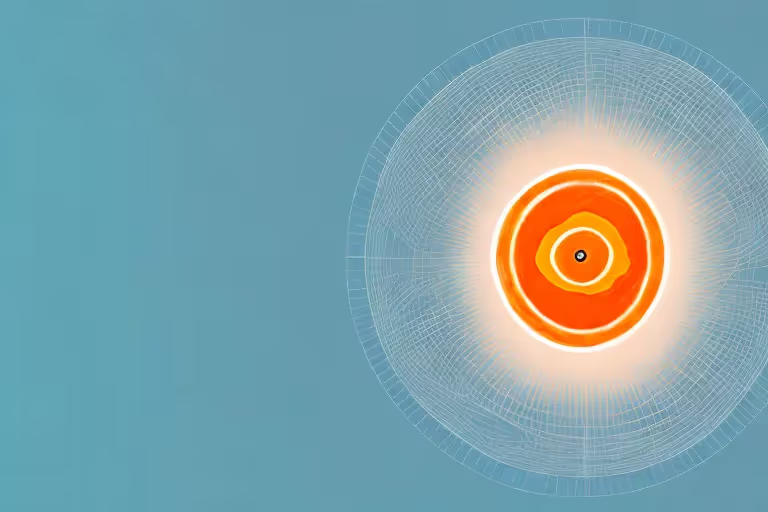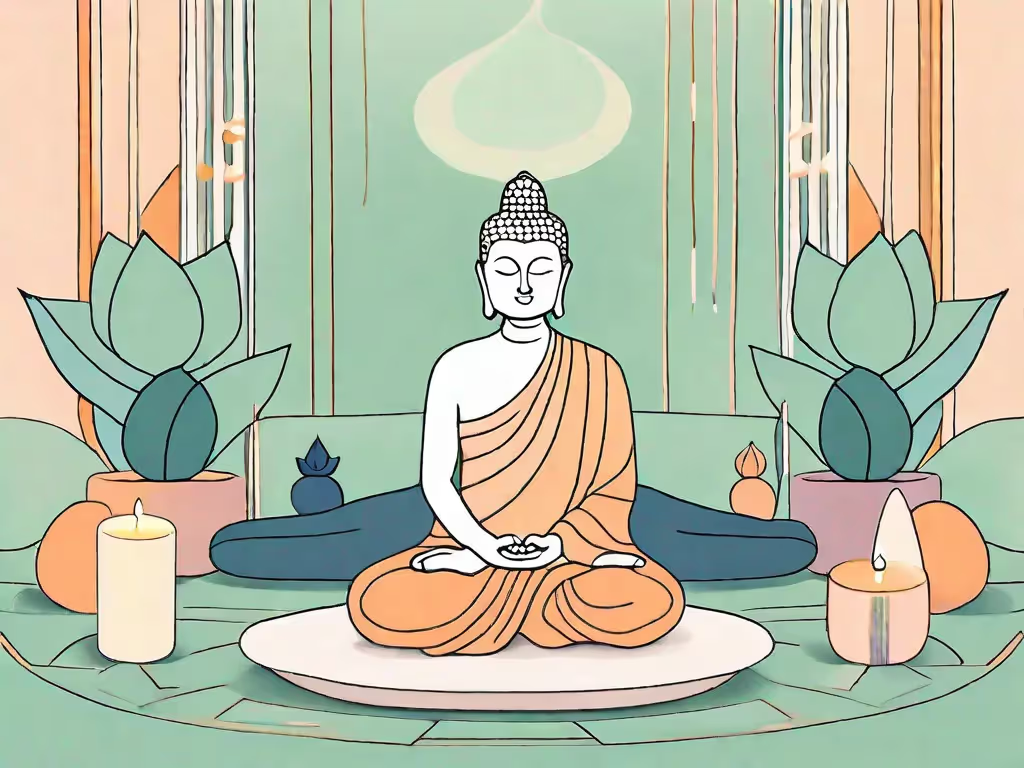In today's fast-paced world, finding inner calm and peace can seem like an elusive goal. However, there is a powerful tool that can help us tap into our innate serenity – Vagus Nerve Meditation. By understanding the role of the vagus nerve in our bodies and exploring the science behind this practice, we can learn to navigate the stresses of life with grace and ease.
Vagus Nerve Meditation
The vagus nerve, also known as the "wandering nerve," is one of the longest nerves in the body. It runs from the brainstem to various organs, including the heart, lungs, and digestive tract. This nerve plays a crucial role in regulating our body's response to stress and promoting overall well-being.
But what exactly does the vagus nerve do? Let's delve deeper into its fascinating functions.
The Role of the Vagus Nerve in the Body
The vagus nerve acts as a communication pathway between the brain and the body. It helps regulate heart rate, breathing, digestion, and even immune function. This means that the vagus nerve is involved in some of the most fundamental processes that keep us alive and thriving.
When the vagus nerve is functioning optimally, it promotes relaxation and a sense of calm. It sends signals to the brain that everything is okay, allowing us to rest and rejuvenate. On the other hand, when the vagus nerve is not functioning properly, it can lead to a variety of health issues.
Aura has the world’s largest and best collection of Meditations and hundreds of Coaches to choose from.
Try it Free!
The Connection Between the Vagus Nerve and Stress
Stress takes a toll on our bodies and minds, often leading to anxiety, depression, and other health issues. But did you know that chronic stress can also impair the function of the vagus nerve?
When we are under stress, the body's fight-or-flight response is activated, which is controlled by the sympathetic nervous system. This response prepares us to either fight or flee from a perceived threat. However, if this response is constantly activated, it can put a strain on the vagus nerve.
When the vagus nerve is compromised, we may experience symptoms such as increased heart rate, shallow breathing, and digestive disturbances. These symptoms are a result of the body being stuck in a state of heightened alertness, unable to switch back to a relaxed state.
So, how can we support the health and function of the vagus nerve?
One effective method is through vagus nerve meditation. This practice involves specific techniques that stimulate the vagus nerve, activating the relaxation response and counteracting the harmful effects of stress. By incorporating vagus nerve meditation into our lives, we can enhance vagal tone, which refers to the strength and efficiency of the vagus nerve's function.
There are various ways to practice vagus nerve meditation, such as deep breathing exercises, yoga, and mindfulness meditation. These practices help activate the parasympathetic nervous system, which is responsible for promoting relaxation and restoring balance in the body.
By regularly engaging in vagus nerve meditation, we can improve our overall well-being and resilience to stress. It's a powerful tool that allows us to take control of our nervous system and cultivate a sense of calm in our daily lives.
The Science Behind Vagus Nerve Meditation
Recent scientific research has shed light on how meditation affects the vagus nerve and our overall well-being. Studies have shown that regular meditation can increase vagal tone, leading to improved emotional resilience, better heart health, and enhanced digestion.
The vagus nerve, also known as the "wandering nerve," is the longest cranial nerve in the body. It originates in the brainstem and travels down through the neck, chest, and abdomen, innervating various organs along the way. This nerve plays a crucial role in regulating our body's stress response and maintaining homeostasis.
How Meditation Affects the Vagus Nerve
During meditation, our body activates the parasympathetic nervous system, which is responsible for the rest-and-digest response. This activation stimulates the vagus nerve, triggering a cascade of beneficial effects throughout our body.
As we enter a state of deep relaxation and focus during meditation, our heart rate slows down, our blood pressure decreases, and our breathing becomes slower and deeper. These physiological changes are mediated by the vagus nerve, which helps to bring our body into a state of balance and harmony.
Research has also found that meditation reduces the production of stress hormones, such as cortisol, and decreases inflammation in the body. At the same time, it increases the release of calming neurotransmitters, such as serotonin and gamma-aminobutyric acid (GABA). These neurochemical changes contribute to a sense of peace and relaxation.
The Health Benefits of Vagus Nerve Stimulation
The health benefits of vagus nerve stimulation are extensive. Studies have shown that this practice can lower blood pressure, improve heart rate variability, and enhance immune function. It has also been associated with reduced anxiety, improved mood, and better cognitive function.
Furthermore, vagus nerve stimulation has been found to have a positive impact on a variety of conditions. For individuals struggling with depression, research has shown that stimulating the vagus nerve can lead to a significant reduction in symptoms. Similarly, patients with chronic pain have experienced relief through vagus nerve stimulation, as it helps to modulate pain signals in the body.
In addition, vagus nerve stimulation has shown promise in the treatment of epilepsy. By delivering electrical impulses to the vagus nerve, seizures can be reduced in frequency and severity. This non-invasive approach offers hope to individuals living with this neurological disorder.
Moreover, vagus nerve stimulation has been explored as a potential therapy for inflammatory disorders, such as rheumatoid arthritis and Crohn's disease. By dampening the inflammatory response, this holistic approach to well-being can truly transform the lives of those affected by these chronic conditions.
In conclusion, the science behind vagus nerve meditation is fascinating and holds great promise for improving our overall well-being. By understanding how meditation affects the vagus nerve and harnessing its power, we can unlock a multitude of health benefits and cultivate a greater sense of peace and balance in our lives.
The Basics of Vagus Nerve Meditation
Now that we understand the science behind vagus nerve meditation, let's explore the practical aspects of this powerful practice. By following some simple steps, we can incorporate this transformative technique into our daily routine.
Vagus nerve meditation is a practice that focuses on stimulating the vagus nerve, which is a key component of the parasympathetic nervous system. This nerve plays a crucial role in regulating various bodily functions, including heart rate, digestion, and stress response. By engaging in vagus nerve meditation, we can activate the relaxation response and promote overall well-being.
Preparing for Vagus Nerve Meditation
Creating the right environment is vital for our meditation practice. Find a quiet and comfortable space where you won't be interrupted. This could be a cozy corner in your home, a secluded spot in nature, or even a dedicated meditation room. Make sure the temperature is pleasant and the lighting is soft to create a soothing atmosphere.
As you prepare for your vagus nerve meditation session, consider using props to support a relaxed and upright posture. Cushions, meditation stools, or even a comfortable chair can help you maintain a position that is both comfortable and alert. This will allow you to fully immerse yourself in the practice without any physical discomfort.
In addition to setting up the physical space, it's important to set aside dedicated time each day for your vagus nerve meditation practice. Consistency is key when it comes to reaping the benefits of this technique. Choose a time that works best for you, whether it's in the morning, during a lunch break, or in the evening before bed. By making it a regular part of your routine, you'll be able to deepen your practice and experience its transformative effects.
Step-by-Step Guide to Vagus Nerve Meditation
Now that you're ready to begin your vagus nerve meditation, let's walk through the step-by-step process:
- Find a comfortable position: Sit in a way that allows your spine to be straight and your body to be relaxed. You may choose to sit cross-legged on a cushion, kneel on a meditation bench, or sit on a chair with your feet flat on the ground.
- Take a few deep breaths: Close your eyes and take a moment to settle into your body. Take a few deep breaths, inhaling through your nose and exhaling through your mouth. Allow any tension or stress to melt away with each breath.
- Shift your focus inward: With your eyes closed, bring your attention to the sensations in your body. Notice how your body feels as you sit in stillness. Feel the weight of your body on the cushion or chair, and the gentle rise and fall of your chest as you breathe.
- Observe your breath: Now, shift your focus to your breath. Notice the natural flow of your breath as it enters and leaves your body. Pay attention to the sensation of the breath moving in and out of your nostrils or the rise and fall of your abdomen.
- Imagine the soothing sensation: As you continue to observe your breath, imagine a soothing sensation traveling along the pathway of your vagus nerve. Visualize this sensation as a warm, golden light that spreads throughout your body, bringing a sense of calm and relaxation.
- Acknowledge thoughts and distractions: It's natural for thoughts or distractions to arise during your meditation practice. When this happens, simply acknowledge them without judgment and gently bring your attention back to your breath and the soothing sensation of the vagus nerve. Allow any thoughts or distractions to pass by like clouds in the sky.
- Engage all your senses: To deepen your experience, engage all your senses. Notice any sounds around you, whether it's the chirping of birds, the rustling of leaves, or the hum of distant traffic. Feel the texture of the cushion or chair beneath you. If you're outside, feel the warmth of the sun on your skin or the coolness of a gentle breeze.
- Cultivate a sense of gratitude: As you continue your vagus nerve meditation, cultivate a sense of gratitude for the present moment. Reflect on the blessings in your life, big or small. Allow feelings of appreciation and contentment to fill your heart as you connect with the present moment.
- Explore additional techniques: If you feel called to, you can incorporate additional techniques into your vagus nerve meditation practice. Affirmations, for example, can help rewire your brain for positivity and self-empowerment. Visualizations can transport you to a peaceful and serene place in your mind. Loving-kindness practices can cultivate feelings of compassion and connection towards yourself and others.
Remember, vagus nerve meditation is a journey, and each session may be different. Be patient with yourself and allow the practice to unfold naturally. With regular practice, you'll begin to notice the positive effects of vagus nerve meditation in your daily life, such as reduced stress, improved emotional well-being, and enhanced overall health.
Deepening Your Vagus Nerve Meditation Practice
While the basics of vagus nerve meditation lay a strong foundation, there are additional techniques that can take our practice to new depths. By exploring advanced methods and overcoming common challenges, we can continue to grow and evolve on our inner journey.
Advanced Techniques for Vagus Nerve Meditation
On the other hand, if you wish to deepen your vagus nerve meditation practice, you can experiment with other mindfulness techniques such as body scanning, walking meditation, or sound therapy. These practices can enhance your ability to connect with your body and cultivate a sense of inner stillness.
Overcoming Common Challenges in Vagus Nerve Meditation
Despite its countless benefits, vagus nerve meditation can sometimes present challenges. It's normal to experience restlessness, discomfort, or a wandering mind. However, with patience and perseverance, we can overcome these obstacles. Be gentle with yourself and embrace the imperfections of your practice. Remember, it's not about achieving perfection but rather cultivating a state of presence and awareness.
Incorporating Vagus Nerve Meditation into Your Daily Routine
Vagus nerve meditation is most beneficial when practiced consistently. By integrating this powerful technique into your daily routine, you can create lasting changes in your life.
Finding the Right Time and Place for Meditation
Finding the right time and space for meditation is essential. Choose a time of day when you are least likely to be interrupted or distracted. It can be helpful to create a dedicated meditation corner or a peaceful sanctuary where you can retreat for your practice. Surround yourself with soothing elements such as candles, crystals, or nature-inspired decor to create a tranquil atmosphere.
Making Vagus Nerve Meditation a Habit
As with any new habit, consistency is key. Start with just a few minutes of meditation each day and gradually increase the duration as your practice evolves. Using a meditation app like Aura Health can be immensely helpful in establishing and maintaining a regular routine. The app offers guided meditations specifically designed to activate and stimulate the vagus nerve, allowing you to reap the full benefits of this transformative practice.
In conclusion, vagus nerve meditation is a powerful tool for unlocking your inner calm and restoring balance in your life. By understanding the science behind this practice and embracing the various techniques, you can tap into the innate tranquility that resides within you. Make vagus nerve meditation a part of your daily routine and experience the profound benefits it brings. With the guidance of the Aura Health app, you have all the support you need to embark on this transformative journey. Begin your practice today and discover the profound impact it can have on your well-being.
Aura is Your All In One App for Meditation, Mindfulness Wellbeing
Find peace every day with one app for your whole well-being. There is no one-size-fits-all solution to mental well-being. Aura is the first all-in-one wellness app that learns how to best help you. Discover an endless library of expert-created tracks for your well-being, all taught by the world’s best coaches, therapists, and storytellers. With Aura's personalized recommendations, you can find peace every morning, day and night.



.webp)






.avif)

%20(1).avif)


.avif)
.avif)
.webp)


.avif)


















































































































.avif)

















.svg)









